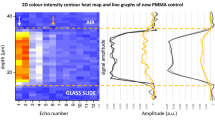Summary
A numerical method for selecting low toxicity plasticizers for glycol methacrylate (GMA) embedding mixtures is described. It involves use of various numerical parameters, namely; molecular weight, melting point, solubility parameter, and toxicity data. On the basis of these parameters, nine plasticizers were selected. Their effects on microtomy and tissue processing, and also their influence on tissue morphology and staining, were investigated. For tissue processed at low temperatures into GMA, using ethanol dehydration, the following compounds were as satisfactory as 2-butoxyethanol whilst being less toxic: 2-isopropoxyethanol, 2-(2-methoxyethoxy)ethanol, 2-(2-ethoxyethoxy)ethanol, 2-(n-butoxyethoxy)ethanol. However for tissues processed using the plasticizer as dehydrating agent, the optimum plasticizers were 2-isopropoxyethanol, 2-(2-methoxyethoxy)ethanol and 2-(2-ethoxyethoxy)ethanol. It is possible to give a numerical specification of the preferred plasticizers, and for the first procedure this is: a solubility parameter in the range 21–26 J0.5 cm−1.5 or higher, a melting point well below 0°C, and a rat oral LD50>12.52 mmol kg−1. It was also possible to analyse the differential effects of the dehydrating agents on histochemical and enzyme histochemical staining on a numerical basis, using a structure-activity relations approach.
Similar content being viewed by others
References
Bancroft, J. D. &Stevens, A. (1982).Theory and practice of histological techniques. 2nd edn. Edinburgh, London, Melbourne, New York: Churchill Livingstone.
Barka, T. &Anderson, P. J. (1963).Histochemistry, Theory, Practice and Bibliography. Hoeber Medical Division New York: Harper and Row.
Burstone, M. S. (1962)Enzyme histochemistry and its application in the study of neoplasm. New York, London: Academic Press.
Chappard, D., Palle, S., Alexandre, C., Vico, L. &Riffat, G. (1987) Bone embedding in pure methyl methacrylate at low temperature preserves enzyme activities.Acta Histochem. 81, 183–90.
Fedors, R. F. (1974) A method for estimating both the solubility parameters and molar volumes of liquids.Polymer Eng. Sci. 14, 147–54.
Frater, R. (1981) Neutralization of acid in glycol methacrylate and the use of cyclohexanol as a plasticizer.Stain Technol. 56, 99–101.
Gächter, R. &Müller, H. (1985)Plastics additives handbook: stabilizers, processing aids, plasticizers, reinforcements, colorants for thermoplastics. 2nd edn. Munich, Vienna, New York: Hanser Publishers.
Gerrits, P. O., &Van Leeuwen, M. B. M. (1984) A comparative study of softeners and catalyst systems upon dimensional changes and sectioning quality of glycol methacrylate sections.J. Microsc 136, 383–5.
Gerrits, P. O. &Van Leeuwen, M. B. M. (1985) Glycol methacrylate embedding in histotechnology: factors which influence the evolution of heat during polymerization at room temperature.J. Microsc 139, 303–11.
Gerrits, P. O. &Van Leeuwen M. B. M. (1987) Glycol methacrylate embedding in histotechnology: the stability of glycol methacrylate sections.Stain Technol. 62, 181–90.
Gerrits, P. O. &Van Leeuwen M. B. M., Boon, M. E. &Kok, L. P. (1987) Floating on a water bath and mounting glycol methacrylate and hydroxypropyl methacrylate sections influence final dimensions.J. Microsc. 145, 107–13.
Gerrits, P. O. &Smid, L. (1983) A new, less toxic polymerization system for the embedding of soft tissues in glycol methacrylate and subsequent preparing of serial sections.J. Microsc. 132, 81–5.
Gerrits, P. O. &Zuideveld, R. (1983) The influence of dehydration media and catalyst systems upon the enzyme activity of tissues embedded in 2-hydroxyethyl methacrylate: an evaluation of three dehydration media and two catalyst systems.Mikroscopie,40, 321–8.
Hansch, C., Leo, A., Unger, A., Kim, S. H. &Lien, E. G. (1973) Aromatic substituent constants for structureactivity correlationsJ. Med. Chem. 16, 1207–16.
Hanstede, J. G. &Gerrits, P. O. (1983) The effects of embedding in water-soluble plastics on the final dimensions of liver sections.J. Microsc. 131, 79–86.
Hantschick, M., Wolf, E. &Dominok, G. (1988) Einfluss der Fixation, Dehydrierung und Polymethacrylateinbettung auf die Ergebnisse immun- und enzymhistochemischer Untersuchungen am lymphatischen Gewebe und Knochenmark.Acta Histochem. 35, 165–77.
Higuchi, S., Suga, M., Dannenberg, A. M., Jr. &Schofield, B. H. (1979) Histochemical demonstration of enzyme activities in plastic and paraffin embedded tissue sections.Stain Technol. 54, 5–12.
Horobin, R. W. (1982a) Staining plastic sections: a review of problems, explanations and possible solutions.J. Microsc. 131, 173–86.
Horobin, R. W. (1982b) Histochemistry: an explanatory outline of histochemistry and biophysical staining. London, Stuttgart: Fischer. Butterworths.
Horobin, R. W. (1989),Understanding staining of water miscible resin sections. Datascope Services (Sheffield), Fifth Court, The University, Sheffield S10 2TN.
Ingamells, W. C. (1980) Important concepts in the dyeing and finishing of man-made fibres.J. of the Society of Dyers and Colourists 96, 466–74.
Karnovsky, M. J. (1965) A formaldehyde-glutaraldehyde fixative of high osmolarity for use in electron microscopy.J. Cell Biol. 27, 137a-8a.
Ruddell, C. L. (1967) Embedding media for 1–2 miron sectioning. Hydroxyethyl methacrylate combined with 2-butoxyethanol.Stain Technol. 42, 253–5.
Sax, N. I. (1984)Dangerous properties of industrial materials. 6th edn. New York: Van Nostrand Reinhold.
Sims, B. (1974) A simple method of preparing 1–2 micron sections of large tissue blocks using glycolmethacrylate.J. Microsc. 101, 223–7.
Author information
Authors and Affiliations
Rights and permissions
About this article
Cite this article
Gerrits, P.O., Horobin, R.W. & Hardonk, M.J. A numerical procedure for choosing effective, low toxicity plasticizers for glycol methacrylate embedding. Histochem J 22, 439–451 (1990). https://doi.org/10.1007/BF01003464
Received:
Revised:
Issue Date:
DOI: https://doi.org/10.1007/BF01003464




